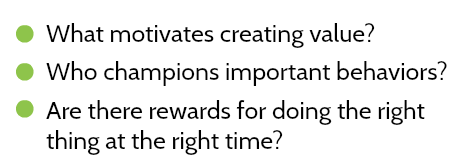Do others try to emulate them? Even try?
By Christopher Allen, MA, PMI-ACP, Product Manager
These obvious questions so often go unanswered. So much depends on knowing, but how do we find out? Beyond asking the questions, what strategies and frameworks are successful in getting credible answers? And what would we do with the answers once found?
What doesn't work
In the hunt for valuable metrics, a performance consultant's first step is often to create a framework for quantifying individual performance. The framework typically has components similar to those of a 360 annual review, end of project performance reviews, or periodic structured 1-on-1 reviews.
And while such performance assessments can help identify areas of concern, employees view them as a game played for promotions, bonuses, and salary increases.
Typical performance assessments don't provide a holistic look at all the behaviors and tasks performed within a department. Even within well-defined roles, the day-to-day behaviors that generate value, mitigate risk, and prepare others for success are often not documented or directly incorporated in review findings.
One alternative is to create a behavior catalog
A behavior catalog itemizes essential behaviors, both effective and wasteful. It attempts to identify for each essential behavior the likely motivating drivers, the relationship to key performance indicators, available support, and associated risks.
Taking a time out to catalog all observed behaviors, both effective and not, provides a basis for identifying differences in poor performance, typical performance, and that extra special something. The behavior catalog will quickly become the resource for archiving the rich and detailed analysis to identify performance issues, as well as, risk, compliance and readiness for change.
Readiness for Change
Force Field analysis, like the diagram shown below, augments behavior catalogs. It provides insight into the current driving and restraining forces that may be in the way of changing a procedure or supporting any value-creating behavior the organization deems necessary for success.

Adjusting for performance
Painting with a really broad brush, we could then place each behavior in the catalog into one of these three categories:
- Following (written) instructions
- Memorizing instructions so they are remembered and followed like written instructions
- Performing effectively as an expert, even if all the variables are combined in a way that's never been seen before
My blueprint for success
Many of us repeat the same patterns year after year, hoping for different results. But perhaps basing our actions on an analysis of behaviors, carefully noting which we want and which we don’t want before we craft a training initiative, will guide us into a fresh and more effective solution.
Tools and techniques to consider when building a catalog
Creating a catalog will take some effort and an open and objective mind. It might even require tasking someone to watch individual performers and take notes. Does that feel like a lot to take on? Yeah, it does to most people. Consider partnering with a third party to create a behavior catalog. That kind of partnership provides several key benefits:
- Objective observers of behavior catalog everything with fresh eyes
- Individual biases and self-fulilling prophecies can be eliminated from the catalog
- Documentation and meeting management are offloaded to external resources
Interested in creating a behavior catalog? Allen Interactions can help. To learn more about behavior catalogs and strategic consulting services offered by Allen Interactions, click here.








